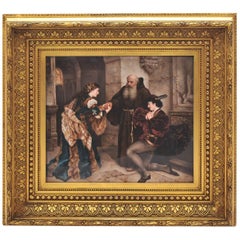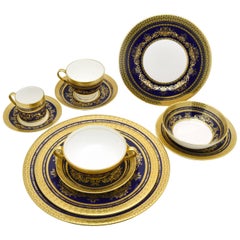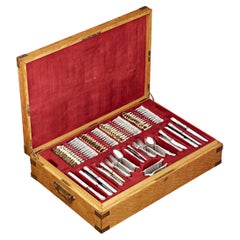Porcelain Plaques Romeo And Juliet
Antique 19th Century Austrian Porcelain
Porcelain
People Also Browsed
Vintage 1980s English Neoclassical Porcelain
Porcelain
20th Century American Tableware
Silver, Sterling Silver
Antique 19th Century English Neoclassical Vases
Ceramic, Porcelain
Antique 19th Century Commodes and Chests of Drawers
Ormolu
Antique 19th Century French Cabinets
Bronze
Antique Early 1900s American Neoclassical Sterling Silver
Sterling Silver
Early 20th Century French Glass
Antique 19th Century American Rococo Tableware
Silver
Vintage 1910s German Art Nouveau Vases
Metal
Antique Early 19th Century Russian Neoclassical Vases
Porcelain
Early 20th Century French Neoclassical Vases
Ormolu
21st Century and Contemporary French Crystal Serveware
Crystal
Antique 15th Century and Earlier Italian Decorative Bowls
Rock Crystal
Antique 19th Century Russian Empire Vases
Bronze
Antique 19th Century French Mantel Clocks
Marble, Carrara Marble, Ormolu, Bronze, Brass
Antique 1850s English Baroque Sterling Silver
Sterling Silver
KPM Porcelain for sale on 1stDibs
The Königliche Porzellan-Manufaktur Berlin, or KPM (Royal Porcelain Factory, Berlin, in English) was one of the most influential porcelain factories to emerge in 18th-century Germany, along with Nymphenburg and Meissen. KPM was the third incarnation of a company originally founded in 1751 by Wilhelm Caspar Wegely to take advantage of the burgeoning market for “white gold.” On the verge of bankruptcy, Wegely sold his inventory and tools to Johann Ernst Gotzkowsky, who in 1761 established another porcelain factory, which also failed, and was subsequently taken over by Frederick II of Prussia in 1763. Like Augustus II, Elector of Saxony, the patron of Meissen and a keen collector who described himself as suffering (quite happily) from “porcelain sickness,” Frederick II was proud to refer to himself as KPM’s “best customer.” KPM produces china and figurines to this day, and throughout its long history, it has been a style-setter for elegant tableware, particularly in the 1930’s, the period during which their popular patterns Urbino, Urania and Arkadia were designed.
Thanks to its royal patronage, KPM had the resources and contacts necessary to establish itself as a leading luxury producer, and supplied Russian and European elites with tableware in the Rococo and Neoclassical styles, as well as monumental vases, and decorative plaques. Many of these objects can be found today in major museums as a result of Frederick II’s penchant for sending KPM porcelain as diplomatic gifts throughout Europe. Unlike Meissen, which was known for crafting porcelain sculptures of dazzling complexity, KPM is revered for the precision and splendor of its surface decoration, and for its porcelain plaques depicting scenes from history and mythology. One especially lovely example circa 1790 is a neocalssical-style tea service decorated with gold accents and a grisaille design of figures from the ancient world. By contrast, this boldly colorful narrative cup and saucer set from the 1840’s depicts scenes from real life as colorfully as a painting. The set was commissioned by a gentleman for his wife as a tongue-in-cheek gift commemorating her misadventures while in town for a visit to the opera, which resulted in her opera glasses being stolen. The saucer shows the thief and the glasses, and the cup reveals the scene of the crime in vivid hues.
KPM was forced to move from its original location in 1867 due to the building of the new Prussian Parliament building, and this afforded the company the opportunity to to create a new factory with the newest equipment and materials of the day. With the growing popularity of Art Nouveau and the western fascination with Asian ceramics, KPM began formulating glazes that evoked the color palette and rich surfaces of Chinese porcelain. By the turn of the century, KPM was exhibiting its wares to a global audience at international expositions. At the end of World War I with the collapse of the Prussian monarchy, KPM was renamed the State Porcelain Manufactory Berlin, continuing to use the name KPM and its use of the cobalt blue sceptre mark that is painted on the bottom of every piece.
By the late 1920’s, the designers and craftsmen of KPM were inspired by the tenets of Modernism, particularly the styles of the Bauhaus and the Deutscher Werkbund. During this period, the firm’s aim was to produce useful household porcelain for a range of consumers, rather than catering to a small elite. Among the most successful patterns of this era was designer Trude Petri’s Urbino line, which is still produced today. Following World War II, KPM was temporarily housed in the town of Selb, and only returned to its rebuilt quarters in Berlin in 1957. In the 1980s, KPM became an private company independent of the state, and began to focus production on the preservation of historic forms, designs, and techniques. KPM continues to collaborate with designers from all over the world, most recently on the Berlin dinnerware service with designer Enzo Mari, and a collaboration with the luxury brands Bottega Veneta and Bugatti.
Finding the Right porcelain for You
Today you’re likely to bring out your antique and vintage porcelain in order to dress up your dining table for a special meal.
Porcelain, a durable and nonporous kind of pottery made from clay and stone, was first made in China and spread across the world owing to the trade routes to the Far East established by Dutch and Portuguese merchants. Given its origin, English speakers called porcelain “fine china,” an expression you still might hear today. "Fine" indeed — for over a thousand years, it has been a highly sought-after material.
Meissen Porcelain, one of the first factories to create real porcelain outside Asia, popularized figurine centerpieces during the 18th century in Germany, while works by Capodimonte, a porcelain factory in Italy, are synonymous with flowers and notoriously hard to come by. Modern porcelain houses such as Maison Fragile of Limoges, France — long a hub of private porcelain manufacturing — keep the city’s long tradition alive while collaborating with venturesome contemporary artists such as illustrator Jean-Michel Tixier.
Porcelain is not totally clumsy-guest-proof, but it is surprisingly durable and easy to clean. Its low permeability and hardness have rendered porcelain wares a staple in kitchens and dining rooms as well as a common material for bathroom sinks and dental veneers. While it is tempting to store your porcelain behind closed glass cabinet doors and reserve it only for display, your porcelain dinner plates and serving platters can safely weather the “dangers” of the dining room and be used during meals.
Add different textures and colors to your table with dinner plates and pitchers of ceramic and silver or a porcelain lidded tureen, a serving dish with side handles that is often used for soups. Although porcelain and ceramic are both made in a kiln, porcelain is made with more refined clay and is stronger than ceramic because it is denser.
On 1stDibs, browse an expansive collection of antique and vintage porcelain made in a variety of styles, including Regency, Scandinavian modern and other examples produced during the mid-century era, plus Rococo, which found its inspiration in nature and saw potters crafting animal figurines and integrating organic motifs such as floral patterns in their work.


